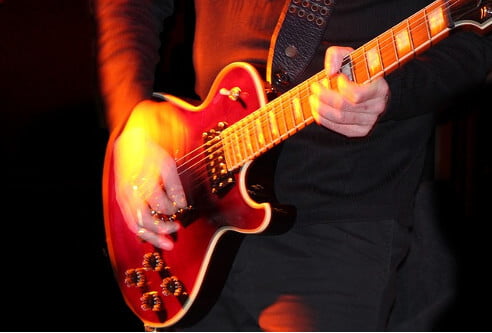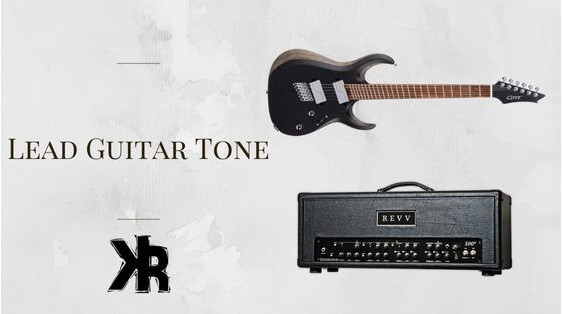Table of Contents
Maybe you have been playing lead guitar for a while now, but just can’t get the right sound. You’ve tried different electric guitars, amps, instruments, and pedals.
But you still can’t seem to get that sound you’re looking for. Does this seem familiar? I am happy to say, there are ways to improve your lead guitar tone!
The lead guitar tone is reliant on distortion or gain. The right equalization of frequencies, sustain, and the right supporting equipment. But to get all this to work right when the pieces are put together takes experimentation.
In this Killer Rig article, we are going to look at the fundamental parts that create a good lead tone. We’ll help you get the sound in your head! In my many years of chasing tone, sometimes you simply need to start again.
Fundamentals of Lead Guitar Tone
When it comes to creating a lead sound that cuts through the mix, there are a few things to consider.
- Gain, distortion, or saturation
- Equalization of guitar frequencies
- Volume levels
- Pick up configurations
- Condition of your equipment
When thinking about these points, we have to look deeper into how we can manipulate them. All to produce a silky lead tone. This comes with testing and experimentation. But there are some good starting points to touch on.
Distortion and Saturation
The lead guitar sound should have some saturation to it. This means that the tone is being pushed into clipping by an amplifier or other external device.
Something like an amp modeler when the gain control is turned up. This distorted signal is a primary part of the lead tone. It needs to be just right depending on the sound you are aiming for.
Some lead tones need more distortion than others. This will affect your sustain and natural compression and should be set to taste.
It’s very easy to use too much and have your rig become a mess of unwanted frequencies. All at the expense of sustain, so experiment with different settings.
The clipped signal becomes asymmetrical or square. This also produces new harmonics or overtones that were not part of your original sound. But this relies heavily on other settings as well, including your electric guitar’s tone knob.
Also make sure to never overlook things like the speakers and feedback. Because of the gain and volume needed, these factors can have a drastic effect on your overall tone.
This brings us to our next point, equalization!
Equalizing Guitar Frequencies
Saturation is great for creating a lead tone. But to tailor it, certain frequencies need to be attenuated out of the signal.
This is where equalization steps in. This is a process that allows you to manipulate different frequency bands for tones.
Your amplifier’s EQ band needs to be set with a lead in mind. These guitar parts are usually more complicated than others.
They rely on a different tone to help them sound proper. Generally, lead tones are brighter with more treble and presence. They are more robust, and fuller with a higher mid-range component.
This means that you need to listen critically. Especially when equalizing the signal for these guitar parts. Otherwise, they may not sit well in the mix. To keep it simple, generally think about boosting frequencies between 800 Hz to 3kHz. While attenuating or cutting some lows around 300Hz.
Any other guitar parts will normally be scooped, so this will help a lead sit on top. Remember that your amp’s EQ is after any clipping stages. So proper use of your electric guitar’s tone knob can also help with this and any overtones. So if you do not use it currently, consider making it a part of your sound.
Volume Level
Gain and volume are very closely related, and so it’s important to get the right balance. With any increases in gain, you will naturally have more volume from an amplifier. So you will want to set your level last, once you have experimented with the gain and Equalization.
Find your settings, then adjust the amp’s volume control to taste.
And because lead parts need different levels, it does make sense to have a volume pedal in your rig. A robust pedal can help you find the right volume needed in a pinch. Instead of relying on your amplifier’s control in a panic.
Being a lead player means adapting quickly on the fly, and so if you do not have one yet, you may want to consider it. If the volume gets too loud, it can become abrasive, especially with lead tones. You want to prevent this at all costs.
Pickup Configurations
Some of the best lead tones come from both humbucker and single-coil pickups. You will need to choose the one that best suits your requirements. Things like signal output and tone are quite different between the two.
Then there is the configuration of pickups. This consist of both neck and bridge positions. This is all changed via your pickup switch. Learning to use them for different lead parts will be extremely important. No one lick will be the same in every song.
Because your neck pickup is warmer sounding, experiment with this for melodies. Parts that don’t need to cut through other instruments. This can be helpful when you want to support the rhythm parts.
Your bridge pickup being brighter is great for solo parts. Anything that needs to cut through the rest of the mix. With your tone knob, the lead guitar sounds can range quite drastically. So experimentation is key.
Then there is the combination of the two, which is a very bold sound. This will be a mid-range thick sound that will be useful for parts that can use some support. With an emphasis on the lead.
Equipment Condition
While you may have the best gear available on the market, if it’s not set up correctly, it will degrade your lead tone.
One of the very first things to do is to make sure your gear is in great shape. If you feel you are experiencing tuning issues, have your intonation checked out.
You may simply need a professional to take a look at your gear to get the optimal sound. Maybe you are using the wrong strings for the lead guitar tone, this too will make a difference. So try a few different sets and see what fits the sound you seek better.

Guitar Effects
With a lead guitar tone, certain effects are needed to get the perfect sound and performance. This doesn’t mean you must load up a pedal board with things that will not be used. But there are a few important effects that you will want to have available.
Distortion
If you do not use an amplifier or prefer to run it clean, some distortion pedals on the market sound just like tube amps. Some of them sound even better than a lot of amps you can buy. There are a lot of lead players who get their distortion and sustain from pedals and are quite happy.
And so, if your amplifier is not getting you the sound you are looking for. Then considering a distortion pedal is a great alternative.
Overdrives and Boosts
Just like distortion pedals, overdrives and boosts are another great way to add just a bit more. A push in the aggressiveness of your tone.
Certain lead tones don’t need as much gain or saturation as others. An overdrive or boost can add just the right amount of push to a sound when it’s needed.
Sometimes you may want to play with less gain, so pedals like this can be very handy and worth looking into.
Reverb
Reverb is a key effect, and not just for lead, but for all types of playing. It adds dimension and character to the sound and helps fill space in the mix. They are also great for parts that need to be dark, moody, or ominous sounding.
From surf music styles to doom metal, reverb is a lead guitar staple and should be part of your tone.
Delay
Delay is an effect that adds depth and distant quality to your lead guitar sound. This type of pedal can widen out the tone and make it transcendent.
This goes great with parts that do not need as much aggression or gain, but more repetition instead.
Most lead playing needs some sort of delay. Checking out what the pros use is a good way to see if you should add it to your electric guitar tone.
Octave Pedals
While octave pedals are not necessary, it was worth a mention. I have had some cool sounds with them and lead playing. And just like the name says, they add another octave up or down to your guitar pitch. These can be very useful for adding some fun and versatility to playing.
These pedals are great for parts that either need to be futuristic or spacey in sound. Another use for the octave pedal is to create an aggressive lead sound. One that does not need as much gain or saturation, but still needs some punch.
Conclusion
Lead can be quite simple with just an electric guitar and an amp. But there are many pedals today that can make it more complex.
You may find some lead players will use all these different pedals at once, or only one of them for certain parts. But this style is not written in stone, and you should experiment to see what gear works for you.
So if lead guitar playing is something you enjoy, don’t be afraid to experiment. Especially with pedals to find your tone perfection. And keep in mind that this equipment can work well with other styles, not just rock music!
FAQs
How Do You Thicken a Lead Guitar Tone?
There are a lot of lead guitar players who add in octave pedals to beef up their tone. Also, adding some delay helps widen out parts and can help thicken lead sounds too.
You should also consider your choice of pickups and the configuration. Some can produce a thin sound.
What Does a Wah Pedal Do for the Lead Guitar Tone?
The wah pedal is a very common lead guitar effect. It’s used to create a vocal-type tone for parts. It can be used to simply add some character and dimension that are high-pitched.
How Do You Make Metal Lead Tones?
There is a certain lead tone that metal players strive for. They often involve heavy distortion. But keep in mind, their tone is about as aggressive as a lead can get and is far beyond a simple crunch.
They also prefer higher levels of compression and do not scoop their mid-range. Just be careful not to add too much bass, as it can lose tightness with this much gain.

